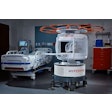
The COVID-19 pandemic has significantly impacted the everyday life of radiologists, forcing many to work remotely. But they must have the right technology to do so. More than simply a computer and monitors, these remote setups are considered trusted medical devices and are the primary interface between radiologists and patient data. Therefore, medical displays and how they are managed are important concerns.
Working remotely creates challenges for hospital and private practice IT personnel, who have to make sure that monitors are correctly calibrated to operate at the optimal level. But lockdown, social distancing rules, and individual radiologist concerns make it difficult for IT professionals to personally visit every radiologist's home to confirm that systems are set up properly.
AuntMinnie.com spoke with radiologists and imaging professionals to understand the challenges and necessities of facilitating remote radiology work.
Set standards
The consistent presentation of images on workstations is essential for electronic imaging operations. The American College of Radiology (ACR), the American Association of Physicists in Medicine, and the Society for Imaging Informatics in Medicine have published practice guidelines and technical standards for the electronic practice of medical imaging, which cover many display technical requirements, including calibration and luminance. The ACR also has published a reference guide.
Cost concerns
Facilitating remote reading are advances in display technology that have made available less expensive off-the-shelf (OTS) monitors for remote interpretations. These monitors can be coupled with calibration software and provide images with quality similar to that of images provided by medical-grade monitors, at much less cost -- several hundred dollars compared with several thousands of dollars for medical-grade monitors.
 Dr. Christoph Wald.
Dr. Christoph Wald.Cost is a significant concern for remote radiology work, especially when institutions and private practices pass remote reading costs along to radiologists.
"Advances in the display quality of new, more affordable commercial displays have offered a way for hospital radiology departments that are struggling with financial issues to respond to the unexpected need to rapidly deploy new hardware solutions for their staff to work remotely in both a safe and productive manner," said Dr. Christoph Wald, chair of radiology at Lahey Hospital and Medical Center in Burlington, MA; professor of radiology at Tufts University Medical School in Boston; and chair of the ACR Commission on Informatics.
Critical display requirements
Wald's department uses medical-grade monitors in the hospital setting and equivalent performance OTS monitors for remote interpretations. For Wald and his department's IT team, critical display requirements include using one or more monitors capable of properly displaying the medical imaging to be interpreted. Also key are spatial resolution, contrast resolution, backlight luminance headroom, uniformity across the display surface, and stability over time. These must meet all the same rigorous standards as medical-grade monitors. Photometers are needed to measure these values. While they are typically integrated into medical-grade displays, most OTS monitors require testing with an external USB-based photometer.
It's also important to use quality assurance (QA) software, whether a standalone application loaded onto the workstation or a networked application that communicates with an onsite or cloud-based server.
"Our goal was to closely approximate the screen real estate and monitor configuration and performance that our radiologists are used to in their hospital reading room environment. For most of our users, this would include a pair of diagnostic color displays, with at least 3 megapixels of resolution each, along with a pair of companion monitors for displaying various applications and reading tools," Wald explained to AuntMinnie.com. "The bottom line is that home diagnostic monitors are medical devices and thus need to meet or exceed the same specifications that are required onsite in the department."
"High-end consumer-grade monitors targeted for users like graphic artists, CAD designers, and digital video editing can be capable of performance as a diagnostic display. But unlike the gold-standard medical displays, these displays must be checked to see how they are performing out of the box," added Wald.
Radiologists need the same resources in their home machines that they are used to having in their hospital reading rooms, according to Wald. These include machines powerful enough to run multiple resource-intensive applications, PACS, voice recognition and dictation software, patient electronic medical record information, and other tools and diagnostic aids, including AI applications. A hardware-based virtual private network (VPN) connection facilitates remote service, updates, and secure encryption of all data. It also provides radiologists with single sign-on capability. Having such machines can help in avoiding performance issues, he indicated.
In addition to an acceptance test, diagnostic monitors should be evaluated for conformance upon deployment to radiologists' homes. Onsite quality assurance and conformance testing needs to happen at regular intervals best determined by department leadership in conjunction with the advice of a radiation physicist, Wald said. But imaging departments need to assess whether they have the resources to configure, deploy, and then manage a fleet of home workstations.
"The takeaway message is that we try to keep the home hardware as similar as possible to the hospital hardware so that the experience of reading at home is as similar as possible to reading in the hospital," Wald explained.
Up to radiologists
Meanwhile, at Northern California's Sutter Health -- a 24-hospital independent delivery network with nine separate radiology groups -- monitors are the responsibility of the radiologist, explained Dr. Jason Wiesner, a practicing radiologist and director of imaging informatics at Sutter and the medical director of Sutter Health's diagnostic imaging service line.
 Dr. Jason Wiesner.
Dr. Jason Wiesner.Before the pandemic, Sutter Health operated about 150 home workstations. That total doubled when the pandemic hit.
"The pandemic unquestionably accelerated a preexisting trend across our practices toward more remote reading flexibility," Wiesner told AuntMinnie.com. "It began in 2016, when we implemented a fast and efficient viewer that performs server-side rendering and data streaming, allowing for production work in a variety of remote settings. It essentially eliminated a historical bottleneck in the local internet bandwidth and speed."
But now this shift toward more home reading is driving not only significant care quality benefits, such as allowing more subspecialty work distribution and decreasing reliance on outsourced teleradiology providers, but also improving radiologists' work satisfaction," explained Wiesner.
Sutter Health provides medical-grade monitors in its reading rooms, which are DICOM-calibrated and connected to web-based monitoring software. QA software runs every day, letting the radiologists know how many hours a monitor has been on and how many hours of life are left.
"It indicates errors and lets us know when monitors are approaching the low end of the luminance standards, which allows us to plan in advance for routine replacements," Wiesner said of the QA software.
"For remote reading, Sutter provides the workstation, desktop, and keyboard so that privacy and security are maintained in a way that we can guarantee. But purchasing the monitor is up to the radiologists. They can choose whatever they want. It could be a DICOM-calibrated monitor off the shelf that they buy from a vendor. Or they could buy a noncalibrated monitor off the shelf and perform the calibration themselves annually," Wiesner explained. "But we hold them to the ACR standards for luminance and monitor bit depth, for example, and we ask them to calibrate their monitors once a year and report back to us through an attestation process that they calibrated their monitor and that it meets those minimum standards," he continued.
"We leave the rest up to the radiologists. We don't require a certain number of monitors; we don't say what the room lighting should be. It's up to them to understand what works best for them as professionals and allow them to provide the high quality that they are accustomed to in the office. They sign a user agreement with us and are asked to achieve the standard that we have in our office reading locations," Wiesner added.
At Sutter Health, workflow is handled by management without the use of dedicated work distribution software. VPN appliances are used for remote reading and enhanced security. An efficient setup in the home is key to radiologist productivity.
"We all know that radiologists are incredibly busy and might read 150 or more exams during a shift. I always recommend a multi-monitor setup like we have in our offices, for example, with an admin monitor for the electronic health record, another admin monitor with dictation software, and one or two diagnostic monitors. This setup may cost a bit more initially but is key for productivity. Otherwise, you're constantly juggling several programs in different windows, which hinders productivity and can result in errors," said Wiesner, who indicated that ergonomics, specifically having the proper desk and chair, is also important.
Piloting helps
Before the pandemic, the radiology department at Texas Children's Hospital had piloted teleradiology on a few workstations, explained Dr. Andrew Sher, radiology chief of informatics at Texas Children's Hospital. This put the department in a good position to work remotely once the pandemic hit, Sher told AuntMinnie.com.
 Dr. Andrew Sher.
Dr. Andrew Sher."Generally, in terms of lessons learned regarding hardware and software for remote reading, you need to have a very fast and reliable means to connect to the hospital. You want to use a reliable VPN," said Sher.
It's also important to establish policies and governance of workstations regarding remote work, according to Sher. The hospital's medical physicists check the monitors and their calibration software, and clear them for use, before sending them to the radiologists' homes. The department's governance states that imaging informatics personnel do not travel to individuals' homes. So, the radiologists personally must set up their remote workstations after reviewing the setup procedure with informatics personnel at the hospital.
While setting up a remote system requires attention to detail, troubleshooting is among the continuing pitfalls facing remote work, according to Sher. In a hospital setting, IT personnel can address an issue promptly. In a remote location, however, it is imperative to have a VPN so that the remote radiologist can get onto the hospital's (or practice's) network.
Currently, the hospital has in place a hybrid system, using medical-grade monitors in its reading rooms, while allowing radiologists to use FDA 510(k)-cleared OTS monitors bundled with calibration software for remote reading. The quantitative calibration is performed manually at the remote location after the system is set up, Sher indicated, and it is repeated annually.
"The key is to have the image quality where it needs to be. So, we spent the most time making sure that the quality of our images was excellent," Sher noted.
He recommended using at least 2-GB video cards for remote work, with his department upgrading to 4-GB cards as they become available for their at-home systems. The department uses software to optimize and synchronize workflow among the hospital's reading rooms and home workstations. Also facilitating the work-from-home environment is the use of meeting software, which enables radiologists and clinicians to review studies and share images.
Follow the guidelines
Elizabeth Krupinski, PhD, of Emory University suggested to AuntMinnie.com that high-resolution off-the-shelf monitors are fine for most remote reading applications, other than breast imaging, and recommended following the published practice guidelines and standards for system and display requirements.
 Elizabeth Krupinski, PhD.
Elizabeth Krupinski, PhD."The key is to have the monitor set up properly in the first place. You can't just pull it out of the box, plug it in, and hope it's going to work. You have to calibrate it and set it at the proper luminance. You can use [the monitors] as long as you calibrate them and keep on top of the calibration because commercial off-the-shelf monitors are going to fall out of calibration faster than medical-grade monitors," she explained.
Krupinski indicated that sometimes working from home can be challenged by environmental conditions, such as lighting and noise. There are some instances in which lighting levels cannot be adjusted, for example.
"You have to determine the best place to put a monitor, where you can at least try to emulate the conditions of the reading room and where you can adjust the lighting. You've got to have a good internet connection as well as good air circulation because you're putting high-performance monitors and computers in a room that usually doesn't have them. A lot of it is logistics and awareness of what's required," she explained.
"If the computer's connection is poor, radiologists have to be prepared to download images multiple times. They have to be aware of dropped packets of data," she noted. If they are reading remotely, radiologists should be continually aware of the need for calibration and other quality issues more often than they normally would be in the reading room, according to Krupinski.
She emphasized that it's important to have a strategy in place, including policies and procedures, to determine which radiologists are most appropriate to work from home, and which specialties and types of images are to be read remotely. If IT personnel are not able to visit the home, then they will have to train radiologists in how to set up, calibrate, and maintain their systems on a regular basis.
"The use of teleradiology has expanded dramatically," Michael J. Cannavo of consulting firm Image Management Consultants told AuntMinnie.com. "There's a lot more reading at home. There's a mix of off-the-shelf and very specific diagnostic-grade monitors and workstations."
Cannavo indicated that the type of monitor radiologists purchase is frequently determined by the images they are reading. And often, radiologists will go with the most cost-effective option for them. For the most part, only reading breast images would require a medical-grade monitor, he said.
According to Cannavo, the big challenge for radiologists working at home is to make sure their monitors are properly calibrated and that other factors, like luminance, are properly maintained. In addition, radiologists must be sure that they receive all of the correct images for a study and that they have the correct prior reports, he said. In terms of security, data encryption, and a VPN are absolutely necessary. Having the required graphics cards for multiple monitors is a necessity, but most of these concerns are often addressed by the equipment vendor and are not the immediate concern of the radiologist, he added.



















